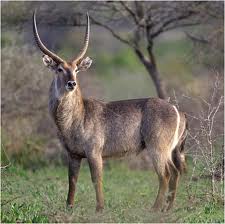Waterbuck
Waterbuck
(Latin = Kobus ellipsiprymnus, Afrikaans = Waterbok - sometimes called “Kringgat”-, German = Ellipsenwasserbock)

(Latin = Kobus ellipsiprymnus, Afrikaans = Waterbok - sometimes called Kringgat, German = Ellipsen wasserbock)
Numbers: Fairly low
Weight: 204 - 270kg (448 - 594 lb.)
Shoulder height: 125 cm (50in.)
Found in the warmest (northern) parts of the Northern Province, especially the Limpopo valley, as well as in the Lowveld areas of Mpumalanga, as well as in a part of central to north east KwaZulu-Natal.
The name of the buck is right on track, being a lover of the waterholes, riverbeds and vlei. And yet, the waterbuck isn't afraid to wander far off from any water. It is sometimes found in hills or steep climbs with no water nearby at all. This massive animal is a beautiful, graceful antelope, with a very distinct white circle around the back rump. An unpleasant smell (to man) accompanies the waterbuck which stems forms glands in the animal's skin. When a hunter hunt to use it's meat, care has to be taken not to slice these glands. Although big, the waterbuck is good at camouflaging itself from intruders. In case of a too close encounter, it will crash out of hiding and make one of the noisiest sprints of all the animals. It is comfortable in water and uses this sometimes as a last resort when pursued by carnivores. Then it will fight viciously with it's very sharp horns and forehead. It can be surprisingly robust and photographers and hunters should take some care not to corner the animal, because it will not hesitate to attack a man or women, all the more when it is wounded.